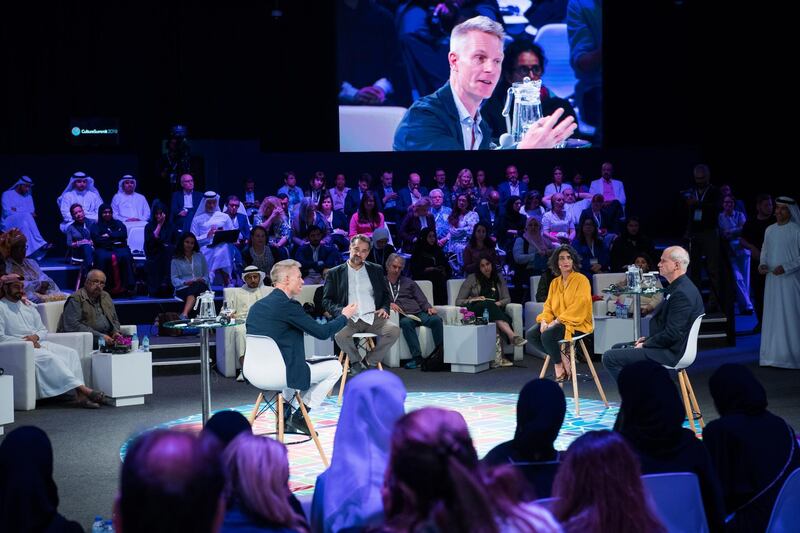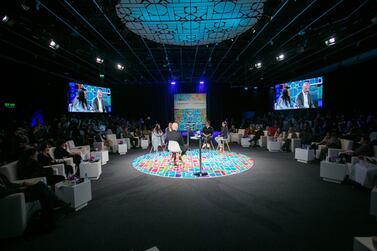After four days of discussions around the media, museums and technology, the Culture Summit closed on Thursday, April 11. One of the most highly anticipated talks on the final day was about freedom of expression. As Tim Marlow, director of London’s Royal Academy and the panel’s moderator put it, “Can we debate freedom of expression? Obviously we can. We are! We’re about to!”
The panellists were the Palestinian artist Khaled Hourani, the artist and philosopher Monica Narula, who is part of the New Delhi-based Raqs Media Collective and Alexander Kellner, director of the National Museum of Brazil.
'Freedom of expression is human'
One key theme emerged throughout the discussion: freedom of expression as a mode of negotiation between artists and cultural authorities. Freedom of expression, the group underlined, is not an abstracted right but a way of working.
Narula led off the debate by differentiating freedom of expression from freedom of speech, which comes, she said, in response to the state.
"The freedom of expression is more human," she said. "We love, we create." She gave two examples from the collective's experience in curating shows and creating art works: the research Raqs undertook at the Imperial War Museum in the UK to produce Not Yet at Ease (2018), a work addressing shell shock among British and Indian soldiers during World War I, and their curation of the Shanghai Biennial in 2017. For the work the collective used archival documentation drawn from the Indian subcontinent, and there had been resistance to their alterations to the material.
“The question of how archives can be altered or changed needs to include the postcolonial right to our own history,” she affirmed, though noting that the museum also had a duty of care to the material it owned. There, she underlined, “We had the freedom of negotiation.”
In contrast, when the group curated the Shanghai Biennial in 2017, she suggested there was a stated list of what could and could not be discussed.
“We developed a mode of talking to the public but not the state,” she said. In the end, the only work that was censored by the Chinese authorities was one that already existed on the internet: Forensic Architecture’s video reconstruction of a rescue operation in the Mediterranean, when a boat bearing around 140 migrants gave a distress call off the coast of Tripoli. Narula said the Chinese authorities apparently feared would offend their allies.
Freedom of expression in statelessness
Hourani entered the debate from a Palestinian context, where he said there were “two governments, but no state”. The Ramallah-based artist took care to present freedom of expression as one of a number of freedoms that exist – or don’t exist – for a people, such as the freedom of keeping silent or the freedom of being alive.
“There’s also a freedom of expression out of a chaos when the state is not present,” he continued. “That gives authority to everyone.”
Continuing this growing sense of freedom as a mode of negotiation, Hourani presented arguably his best-known work, the 2011 project Picasso in Palestine, when he brought a Picasso portrait from a Dutch museum collection to be on show in Ramallah for a month. The key to this project – bringing a priceless and world-class painting to a place that much of the world deems fundamentally unstable – was as much the opportunity it gave to the Palestinian people in the West Bank to see the 1943 Buste de femme, as to also open a space of negotiation with the insurance companies, lenders, museum and state authorities to make the idea of such an exhibition possible.
A world of contrast
Finally, Kellner, who operates the National Museum of Brazil, underscored that the freedom of expression could not be separated from responsibility: artists should have the freedom to say what they like, but they must be ready to be held accountable for their statements.
“In Brazil we are scared,” he said. “Culture, science, we are scared. Because the levels of funding [are] going down. But [at least] we are able to say so.”
Artists, he continued, create artwork, but are surrounded by an apparatus of curators and museums officials who also take on some of the contextualisation and negotiation around their work.
The discussion also took in the importance of speaking impartially about the future, specifically in allowing the younger generation to discuss the climate crisis. “There is the question of how the narrative is told,” Narula said. “But also the future: we are changing into a world we won’t recognise soon enough.”
The emphasis on giving over platforms to the new generation also dominated the plenary discussion, which the Culture Summit MC Mohammed Al Otaiba moderated among Mohamed Khalifa Al Mubarak, Alexandra Munroe, Tim Marlow, Anna Paolini and John Prideaux.
Al Mubarak, chairman of event organisers DCT, stressed the continuity of tolerance, from its importance for Sheikh Zayed bin Sultan Al Nahyan to the next generation. Fittingly, one of the panellists spied Al Otaiba’s young daughter in the audience, and they invited her onto the stage as an example of this young generation that sweetly closed the event.
“Aamna, why are you here today?” Al Otaiba asked her. She was a model of honesty. “So I can hear daddy talking,” she said.
“Have you been inspired, listening to all these people?”
“No,” she replied. The audience laughed and Al Otaiba kissed her on the head. Youth, they take everything we give and still want more, and so it should be.







